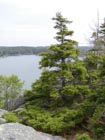
A small tree on a rocky outcrop on Vinalhaven Island, Maine [C.J. Earle, 2003.07.18].

Foliage on the above tree. The "tufted" appearance distinguishes this species from Picea glauca or P. mariana [C.J. Earle, 2003.07.18].
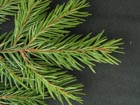
Upper side of twigs and foliage from a tree on Mt. Mitchell, North Carolina [C.J. Earle, 2004.10.25].
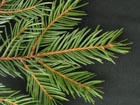
Lower side of twigs and foliage from a tree on Mt. Mitchell, North Carolina [C.J. Earle, 2004.10.25].
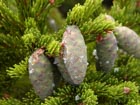
Current year cones on the above tree. Cone size is intermediate between Picea glauca and P. mariana [C.J. Earle, 2003.07].
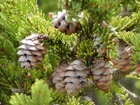
Previous year cones on the above tree [C.J. Earle, 2003.07.18].
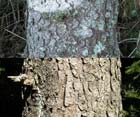
Bark on 30 cm (above) and 35 cm (below) dbh trees on Mt. Mitchell in North Carolina [C.J. Earle, 2004.10.25].
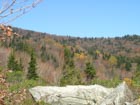
Trees in habitat on Grandfather Mountain, North Carolina [C.J. Earle, 2004.10.26].

Pure stand in the White Mountains of New Hampshire [Jeff Bisbee, 2012].
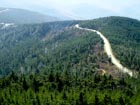
Abies fraseri and Picea rubens spruce forest along the Mt. Mitchell summit road. See text for discussion of mortality [C.J. Earle, 2004.10.25].

Conservation Status

Picea rubens
Sargent 1898
Common names
Red spruce, eastern spruce, yellow spruce, épinette rouge (Canadian French) (Taylor 1993).
Taxonomic notes
Syn: Picea australis Small 1903; P. nigra (Aiton) Link var. rubra (DuRoi) Engelmann; P. rubra (DuRoi) Link 1831, not A. Dietrich 1824. In eastern Canada this species hybridizes to a limited extent with P. mariana (Taylor 1993).
Description
Trees to 40 m tall and 100 cm dbh; "crown narrowly conic. Bark gray-brown to reddish brown. Branches horizontally spreading; twigs not pendent, rather stout, yellow-brown, densely pubescent to glabrate. Buds reddish brown, 5-8 mm, apex acute. Leaves 0.8-2.5(3) cm, 4-angled in cross section, somewhat flexuous, yellow-green to dark green, not glaucous, bearing stomates on all surfaces, apex mostly acute to sharp-pointed. Seed cones 2.3-4.5(5) cm; scales broadly fan-shaped, broadest near apex, 8-12 × 8-12 mm, stiff, margin at apex entire to irregularly toothed. 2n=24" (Taylor 1993). Cones ovoid, glossy, orange-brown (c.f. P. mariana), fusiform, matte. See García Esteban et al. (2004) for a detailed characterization of the wood anatomy.
Distribution and Ecology
Canada: New Brunswick, Nova Scotia, Ontario, Prince Edward Island, Québec; France: St. Pierre and Miquelon; USA: Maine, New Hampshire, Vermont, Massachusetts, Connecticut, New York, Pennsylvania, New Jersey, Maryland, Virginia, West Virginia, North Carolina and Tennessee. Found at 0-2000 m elevation in upper montane to subalpine forests (Taylor 1993). See also Thompson et al. (1999). Hardy to Zone 3 (cold hardiness limit between -39.9°C and -34.4°C) (Bannister and Neuner 2001).
Distribution data from USGS (1999).
Air pollution, including both acid preciptiation and nitrogen deposition, has been implicated in extensive dieback of red spruce forests in the Appalachian Mountains (Eagar and Adams 1992). "Up to now, acid rain has been associated with the decline of forests in certain specific locations. DeHayes and colleagues, UVM senior researcher Gary Hawley and USDA Forest Service scientist and UVM adjunct faculty Paul Schaberg previously documented the mechanism through which acid rain depletes calcium and weakens high elevation red spruce trees, making them more vulnerable to winter freezing injury. Their new work shows that this mechanism is also applicable to other tree species, including balsam fir, white pine, and eastern hemlock. Because calcium is a critical ingredient in the plant's stress response system, acid rain's depletion of cellular calcium may suppress the capacity of trees to survive environmental stresses" (Science Daily, 2002.07.18). There is a huge literature on this subject; to get a sampling, try "acid rain red spruce" in your search engine.
Remarkable Specimens
The official "big tree", and the tallest known specimen, are both within the Great Smoky Mountains National Park. The "big tree" is 44.7 m tall with a 123 cm dbh and 7.3 m crown spread (American Forests 2008). The tallest known tree is 46.33 m tall (Rucker 2003).
On 2005.10.19, the New Brunswick Telegraph-Journal published an account describing how Ben Phillips, a graduate student at Mount Allison University, had found a tree 445 years old while studying the Fundy basin fog forest in New Brunswick, Canada. His major professor, Colin Laroque, informed me that "The tree had a very complex life. We crossdated it with other trees in the stand for about 300 years, and these trees crossdated very well with our other samples from the region. We then crossdated it back for about another 100 years using chronologies from dated and undated historical structures that we had in our database from the region. The tree(s) helped lock in a few floaters and so we are very confident it crossdates back to nearly the pith of the tree. The tree was 13.5 cm from pith to bark on one side and slightly longer on the other. The core was taken at breast height and so it is older than the 445, but we do not want to speculate on how long it took to reach DBH" (Colin Laroque e-mail 2005.19.23).
Formerly, the oldest known individual was 424 years (crossdated) for specimen 106061 collected on Grandfather Mountain, NC by Ed Cook (NCDC 2006).
Ethnobotany
The long roots were pulled up by native peoples, peeled and split for lacing. The pitch was used for patching holes and leaking seams (Native Tech). The gum was formerly collected and processed for chewing gum (Hart 1959). Early settlers (and no doubt some modern homebrewers) used the fresh green foliage to flavor fermenting beer. It is still harvested for timber. Three times (as of 2024) it has served as the U.S. Capitol Christmas tree.
Quite a few dendrochronology studies were done examining the effects of acid rain on tree growth; examples include work by Adams et al. (1990), Cook et al. (1992), and Johnson and Siccama (1989). This species has also been used in many forest decline studies and environmental chemistry studies that grew out of the acid rain work, studies of spruce budworm, studies of climate variation, growth-and-yield studies, forest history studies, and a few methodological and miscellaneous ecological studies.
Observations
Can be readily seen in high elevation forests of the Appalachian Mountains, including the Great Smokies National Park (NC/TN), the White Mountains (NH) and the Adirondacks (NY).
Remarks
The epithet means "red" and may refer either to the bark or to the cones. Lambert (1803) described the species (as Pinus rubens, the Newfoundland red Spruce Fir), and his illustration (Tab. 28) constitutes the type of the species; his Latin description uses "rubra" only to refer to the bark color, but his account in English repeatedly notes the reddish-brown cones, and says they are one of the principal features distinguishing this species from Picea mariana.
Red spruce is the provincial tree of Nova Scotia (Taylor 1993).
Citations
Adams, H. S., McLaughlin, S. B., Blasing, T. J., and Duvick, D. N. 1990. A survey of radial growth trends in spruce in the Great Smokey Mountains National Park as influenced by topography, age, and stand development. Oak Ridge National Laboratory Publication TM-11424. 62 pp.
American Forests 2008. The National Register of Big Trees. Washington, DC: American Forests.
Cook, E. R. and Zedaker, S. M. 1992 The dendroecology of red spruce decline. P. 192-231 in Ecology and Decline of Red Spruce in the Eastern United States (C. Eagar and M.B. Adams, eds.). New York: Springer-Verlag.
Eagar, C. and M.B. Adams (eds.). 1992. Ecology and Decline of Red Spruce in the Eastern United States. Ecological Studies 96. New York: Springer-Verlag.
Hart, Arthur C. 1959. Silvical characteristics of red spruce. Paper No. 124. Durham, NH: U.S. Department of Agriculture, Forest Service, Northeastern Forest Experiment Station. 18 p.
Johnson, A. H. and Siccama, T. G. 1989. Decline of red spruce in the high-elevation forests of the northeastern United States. P. 191-234 in Air Pollution's Toll on Forests and Crops (J.J. MacKenzie and M.T. El-Ashry, eds.). New Haven: Yale University Press.
[NCDC 2006] Data accessed at the National Climatic Data Center World Data Center for Paleoclimatology Tree-Ring Data Search page, 2006.09.08. http://hurricane.ncdc.noaa.gov/pls/paleo/fm_createpages.treering, accessed 2006.09.08, now defunct.
Sargent, C. S. 1898. The silva of North America, V. 12. Boston: Houghton Mifflin (p. 33) (detailed account followed by an excellent illustration).
Science Daily. 2002.07.18. Damage from acid rain pollution is far worse than previously believed. https://www.sciencedaily.com/releases/2002/07/020718075630.htm, accessed 2018.01.20.
See also
Burns and Honkala (1990).
Elwes and Henry 1906-1913 at the Biodiversity Heritage Library (as P. rubra). This series of volumes, privately printed, provides some of the most engaging descriptions of conifers ever published. Although they only treat species cultivated in the U.K. and Ireland, and the taxonomy is a bit dated, still these accounts are thorough, treating such topics as species description, range, varieties, exceptionally old or tall specimens, remarkable trees, and cultivation. Despite being over a century old, they are generally accurate, and are illustrated with some remarkable photographs and lithographs.
Jack, J.G. 1897. Notes on the eastern American spruces. Garden and Forest 10:183. Available at the Biodiversity Heritage Library, accessed 2024.12.24. Fairly insightful early account of the natural history of these species.
Sullivan, Janet. 1993. Picea rubens. In: Fire Effects Information System, [Online]. U.S. Department of Agriculture, Forest Service, Rocky Mountain Research Station, Fire Sciences Laboratory (Producer). Available:
https://www.fs.fed.us/database/feis/plants/tree/picrub/all.html, accessed 2020.11.28.
Mello, Robert A. 1987. Last Stand of the Red Spruce. Island Press. Washington, DC. 199 pp.
Morgenstern and Farrar (1964).










